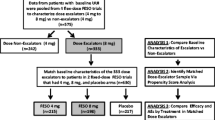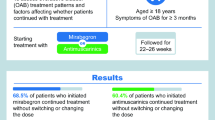Abstract
Introduction and hypothesis
Treatment persistence is low in patients with overactive bladder (OAB), but persistence may vary among antimuscarinic agents. This study compared treatment persistence in patients with OAB receiving fesoterodine, solifenacin, or tolterodine as their initial OAB prescription in a routine clinical practice setting.
Methods
This retrospective study used medical records from primary healthcare centers in three locations in Spain; records from patients aged ≥18 years with a diagnosis of OAB who initiated antimuscarinic treatment for OAB (fesoterodine, tolterodine, or solifenacin) were included. The first prescription of one of the OAB study medications was considered the index date; patients were followed for ≥52 weeks. Persistence was estimated using Kaplan–Meier curves and Cox proportional hazard regression models, adjusting for covariates.
Results
A total of 1,971 records of patients (58.3 % women; mean age 70.1 years) initiating treatment with fesoterodine (n = 302), solifenacin (n = 952), or tolterodine (n = 717) were included. Unadjusted mean (±SD) treatment duration was 31.5 ± 17.6 weeks for fesoterodine, 29.9 ± 21.4 for solifenacin and 29.0 ± 21.6 for tolterodine (p = 0.217). At week 52, 35.8 % of fesoterodine-treated patients remained on their initial therapy, versus 31.9 % of solifenacin-treated (hazard ratio [HR], 1.24; 95 % CI, 1.05–1.47; p = 0.011) and 30.9 % of tolterodine-treated (HR = 1.28; 95 % CI, 1.07–1.52; p = 0.006) patients. Findings were consistent when the definition for discontinuation was varied.
Conclusions
Overall persistence at week 52 was low, but the cumulative probability of persisting with initial therapy was significantly higher for fesoterodine than for solifenacin or tolterodine in clinical practice in Spain.


Similar content being viewed by others
References
Kirby M, Artibani W, Cardozo L et al (2006) Overactive bladder: the importance of new guidance. Int J Clin Pract 60:1263–1271
Coyne KS, Margolis MK, Kopp ZS, Kaplan SA (2012) Racial differences in the prevalence of overactive bladder in the United States from the epidemiology of LUTS (EpiLUTS) study. Urology 79:95–101
Odeyemi IA, Dakin HA, O'Donnell RA, Warner J, Jacobs A, Dasgupta P (2006) Epidemiology, prescribing patterns and resource use associated with overactive bladder in UK primary care. Int J Clin Pract 60:949–958
Martinez Agullo E, Ruiz Cerda JL, Gomez Perez L et al (2009) Prevalence of urinary incontinence and hyperactive bladder in the Spanish population: results of the EPICC study. Actas Urol Esp 33:159–166
Vaughan CP, Johnson TM 2nd, Ala-Lipasti MA et al (2011) The prevalence of clinically meaningful overactive bladder: bother and quality of life results from the population-based FINNO study. Eur Urol 59:629–636
Martinez Agullo E, Ruiz Cerda JL, Gomez Perez L, Rebollo P, Perez M, Chaves J (2010) Impact of urinary incontinence and overactive bladder syndrome on health-related quality of life of working middle-aged patients and institutionalized elderly patients. Actas Urol Esp 34:242–250
Bartoli S, Aguzzi G, Tarricone R (2010) Impact on quality of life of urinary incontinence and overactive bladder: a systematic literature review. Urology 75:491–500
Andersson KE (2011) Antimuscarinic mechanisms and the overactive detrusor: an update. Eur Urol 59:377–386
Nitti VW, Dmochowski R, Sand PK et al (2007) Efficacy, safety and tolerability of fesoterodine for overactive bladder syndrome. J Urol 178:2488–2494
Chapple C, Van Kerrebroeck P, Juenemann K, Wang J, Brodsky M (2008) Comparison of fesoterodine and tolterodine in subjects with overactive bladder. BJU Int 102:1128–1132
Corcos J, Angulo JC, Garely AD et al (2011) Effect of fesoterodine 4 mg on bladder diary and patient-reported outcomes during the first week of treatment in subjects with overactive bladder. Curr Med Res Opin 27:1059–1065
Kelleher CJ, Tubaro A, Wang JT, Kopp Z (2008) Impact of fesoterodine on quality of life: pooled data from two randomized trials. BJU Int 102:56–61
Brostrom S, Hallas J (2009) Persistence of antimuscarinic drug use. Eur J Clin Pharmacol 65:309–314
Sears CL, Lewis C, Noel K, Albright TS, Fischer JR (2010) Overactive bladder medication adherence when medication is free to patients. J Urol 183:1077–1081
D'Souza AO, Smith MJ, Miller LA, Doyle J, Ariely R (2008) Persistence, adherence, and switch rates among extended-release and immediate-release overactive bladder medications in a regional managed care plan. J Manag Care Pharm 14:291–301
Yu YF, Nichol MB, Yu AP, Ahn J (2005) Persistence and adherence of medications for chronic overactive bladder/urinary incontinence in the California Medicaid program. Value Health 8:495–505
Brubaker L, Fanning K, Goldberg EL et al (2010) Predictors of discontinuing overactive bladder medications. BJU Int 105:1283–1290
Oefelein MG (2011) Safety and tolerability profiles of anticholinergic agents used for the treatment of overactive bladder. Drug Saf 34:733–754
Sexton CC, Notte SM, Maroulis C et al (2011) Persistence and adherence in the treatment of overactive bladder syndrome with anticholinergic therapy: a systematic review of the literature. Int J Clin Pract 65:567–585
Haab F, Castro-Diaz D (2005) Persistence with antimuscarinic therapy in patients with overactive bladder. Int J Clin Pract 59:931–937
Gopal M, Haynes K, Bellamy SL, Arya LA (2008) Discontinuation rates of anticholinergic medications used for the treatment of lower urinary tract symptoms. Obstet Gynecol 112:1311–1318
Haylen BT, de Ridder D, Freeman RM et al (2010) An International Urogynecologic Association (IUGA)/ International Continence Society (ICS) joint report on the terminology for female pelvic floor dysfunction. Int Urogynecol J 21:5–26
Steiner JF, Prochazka AV (1997) The assessment of refill compliance using pharmacy records: methods, validity, and applications. J Clin Epidemiol 50:105–116
Benner JS, Glynn RJ, Mogun H, Neumann PJ, Weinstein MC, Avorn J (2002) Long-term persistence in use of statin therapy in elderly patients. JAMA 288:455–461
The International Classification of Primary Care in the European Community: With a Multi-language Layer (1993) Oxford Medical Publications
Charlson ME, Pompei P, Ales KL, MacKenzie CR (1987) A new method of classifying prognostic comorbidity in longitudinal studies: development and validation. J Chron Dis 40:373–383
Wyndaele JJ, Goldfischer ER, Morrow JD et al (2009) Effects of flexible-dose fesoterodine on overactive bladder symptoms and treatment satisfaction: an open-label study. Int J Clin Pract 63:560–567
Castro-Diaz D, Miranda P, Sanchez-Ballester F, Lizarraga I, Arumi D, Rejas J (2012) Dose and aging effect on patients reported treatment benefit switching from the first overactive bladder therapy with tolterodine ER to fesoterodine: post-hoc analysis from an observational and retrospective study. BMC Urol 12:19
Herschorn S, Swift S, Guan Z et al (2010) Comparison of fesoterodine and tolterodine extended release for the treatment of overactive bladder: a head-to-head placebo-controlled trial. BJU Int 105:58–66
MacDiarmid SA (2003) Overactive bladder: improving the efficacy of anticholinergics by dose escalation. Curr Urol Rep 4:446–451
Cardozo L, Amarenco G, Pushkar D, Mikulas J, Drogendijk T, Wright M, SUNRISE Study Group et al (2013) Severity of overactive bladder symptoms and response to dose escalation in a randomized, double-blind trial of solifenacin (SUNRISE). BJU Int 111:804–810
Conflicts of interest
Javier Rejas and Marion Kvasz are employees of Pfizer S.L.U. and Pfizer PIO, respectively. All other authors declare that they have no competing interests.
Funding
Statistical analysis was performed by DataClinics and was funded by Pfizer Inc. Editorial assistance was provided by Colin Mitchell, PhD, of Complete Healthcare Communications, Inc, and was funded by Pfizer Inc.
Author information
Authors and Affiliations
Corresponding author
Rights and permissions
About this article
Cite this article
Sicras-Mainar, A., Rejas, J., Navarro-Artieda, R. et al. Antimuscarinic persistence patterns in newly treated patients with overactive bladder: a retrospective comparative analysis. Int Urogynecol J 25, 485–492 (2014). https://doi.org/10.1007/s00192-013-2250-4
Received:
Accepted:
Published:
Issue Date:
DOI: https://doi.org/10.1007/s00192-013-2250-4




